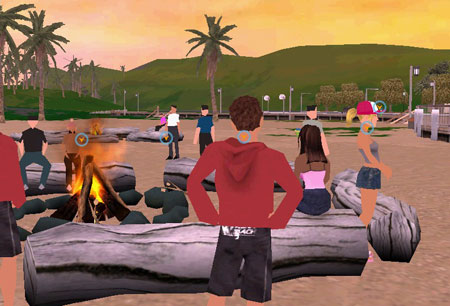Internet Killed the Video Star

Remember when that MTV flag showed up on the moon back on August 1, 1981? MTV quickly became the thing to watch, the place to advertise to young people, the way to launch new bands, a creator of a new TV forms (reality television in the form of The Real World), even a way to reach young voters (see Bill Clinton,1992).
But that was almost 26 years ago and though they liked to say that videos killed the radio, the Internet killed the videos that MTV pioneered. In fact, MTV seems to run more reality programming than music these days (they moved music to the MTV2 channel).
Their TV ratings may be down but their Net presence is way up. That is mostly due to MTV's Laguna Beach Virtual, an online virtual world companion to their Laguna Beach reality (well...) show. MTV execs realized that kids watching the show were going to web sites not in the MTV domain to talk about the show and post, and they wanted those viewers to stay within their MTV.com portals.
This initiative comes from a small group within MTV called Leapfrog. Their mission is portrayed as an attempt to leapfrog sites like MySpace & other social networking sites.
Leapfrog is led by Matt Bostwick, a marketing exec who previously worked with Coca-Cola in Japan where they set up vending machines that rang up the cell phones of people passing by and asked them if they wanted to download Coke ringtones & free beverages.
He was brought to MTV 3 years ago to work on “off-TV activities†and Leapfrog started building a virtual version of Laguna Beach in March 2006. The site uses the technology that runs There.com (another virtual space created by Makena Technologies) rather than the Second Life engine. That makes their VLB less freedom to create than SL, but a faster, smoother world that is largely developer-controlled.
VLB officially launched last September. By November, it had 300,000 people sign up. They like to point out that Second Life took 3 years to get that many users.
The process is similar: register for a free membership, download the application, pick an avatar & clothing and hit the beach. It's more limited than SL, but therefore the learning curve is gentler.
There's an economy in VLB too, but it doesn't seem to be the main goal for right now. There are purchase crossovers (show DVDs, t-shirts for you or your avatar) and a premium service ($6 month) will be available. You get 180 MTV bucks for a US dollar. Brand (show) loyalty is certainly part of the aim of this initiative.
As is often the case for Net ventures, advertising becomes the business model. And, like broadcast & cable TV, product placement is becoming common (IM windows look like Cingular cell phones, virtual Pepsi cans, a Secret deodorant contest about confessing secrets)
Demographics: 55% teenage girls; 40% of users under 17; users average 6 visits a month and average sessions are 35 minutes a session. That 210 minutes a month compares very well with a regular web site for a TV show that averages 30 minutes a month.
What's next from MTV? It seems that they might get back some of their music roots with a music virtual world that looks like a trendy club. You discover bands, share & promote them and if you are good at doing it, you might get to program the music too. Bands can have virtual concerts that can lead to airplay on MTV.
One thing that is clear in all this is that it will be more difficult to be clear about the directions that advertising vs. information and reality vs. virtual reality take. How will this change our incoming students' perceptions, and will it drive changes to the way we deliver our educational content or the way we market our schools?
Comments
No comments